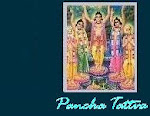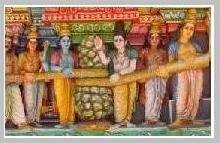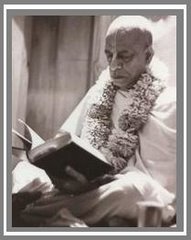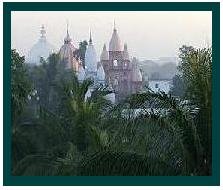 Rupa Goswami developed his style in writing Ujjavla-nilamani after reading these verses (SB 10th Canto), or we can say that these verses of the Bhagavatam (especially those contained within the rasa chapters) were written in the style of Rupa Goswami's Ujjavla-nilamani.
Rupa Goswami developed his style in writing Ujjavla-nilamani after reading these verses (SB 10th Canto), or we can say that these verses of the Bhagavatam (especially those contained within the rasa chapters) were written in the style of Rupa Goswami's Ujjavla-nilamani.Srimad-Bhagavatam is mula-pramana, the original root of all Vedic evidence. Therefore Rupa Goswami composed his poetry in pursuance of the Srimad-Bhagavatam's version. However, because Rupa Goswami is Rupa Manjari and is an eternal associate of Radha and Krsna, he is the root of all understanding. Thus, it is equally true to say that the Srimad-Bhagavatam follows the direction of Rupa Goswami.
Rupa Manjari is the foremost junior cowherd damsel who eternally serves Radha-Krishna under the guidance of the gopi, Lalita-devi.
Rupa Goswami wrote a number of books in Sanskrit on philosophy, poetics, drama and dramaturgy. The following is a list of some of the most well-known works of Rupa Goswami:
* Bhakti-rasamrta-sindhu: ( The Ocean of Nectar of Divine Love) Bhakti-rasamarta-sindhu is considered to be one of the most important books in Gaudiya Vaishnavism. In this work, Rupa Goswami elaborately describes the gradations of bhakti from its lowest stage of sraddha (faith) up to its highest stage of maha-bhava (ultimate ecstasy in love of Godhead).
* Ujjvala-nilamani: ( The Sapphire of Divine Love) This work exclusively explains the conception of madhurya-rasa (divine conjugal love). Ujjvala-nilamani is considered to be a sequel to the Bhakti-rasamrta-sindhu.
* Laghu-bhagavatamrta: (A Summary of Nectar about Godhead) The Laghu-bhagavatamrta is a summary of Sanatana Goswami's book Brhat-bhagavatamrta. The book begins by explaining the intrinsic nature of Krishna and his incarnations and continues to deal entirely with the devotees of Krishna.
* Lalita-madhava & Vidagdha-madhava: This drama was originally written by Rupa as one book. However, it is said that Rupa had a vision of Satyabhama, one of Krishna's queens in Dvaraka, who told him to divide the book into two separate dramas. Thus, Lalita-madhava deals with Krishna's pastimes in Dvaraka and Vidagdha-madhava narrates Krishna's pastimes in Vrindavana. These plays were written between 1524 and 1529 CE)
* Stavamala: (The Flower Garland of Prayers) This is a compilation of short works by Rupa Goswami, some of which are often published as separate books.
* Sri Radha-krsna-ganoddesa-dipika: (A Lamp to see the Associates of Radha-Krsna) In this book, Rupa Goswami lists the associates of Radha and krishna and describes their characteristics. This work was written in 1550 CE.
* Danakeli-kaumudi: (The Lotus-like Tax Pastimes) This drama was written by Rupa Goswami in 1549 CE and narrates the 'tax-collecting pastime between Krishna and the Gopis of Vrindavana.
* Mathura-mahatmya: (The Glories of Mathura) The Mathura Mahatmya tells the glories of Mathura, in the form of a conversation between Varaha (the boar incarnation of Vishnu) and the Earth Goddess. Rupa Goswami explains various processes of devotional service by quoting statements from various vaishnav scriptures and establishes that Mathura vanquishes all one's sinful reactions and awards piety and liberation.
* Uddhava-sandesa: (News of Uddhava) In this work, Rupa Goswami narrates the story from the Bhagavata Purana of Krishna requesting his friend Uddhava to go to Vrindavana and pacify his friends and relations by reminding them of their pastimes with him.
* Hamsa-dutam: (The Swan messenger) The Hamsaduta tells the story how Lalita, the confident of Radha, sends a messenger in the form of a swan to Krishna in Dwaraka.
* Sri Krsna-janma-tithi-vidhi: This short work of Rupa Goswami's is a paddhati (manual on ritual worship) explaining the process of worshiping the deity of Krishna during the festival of Janmastami, the birthday of Krishna celebrated by Vaishnavas in August/September.
* Nataka-candrika: (The Illuminating Moon of Dramatics) This book explains the rules of Gaudiya Vaisnava dramaturgy.
* Upadesamrta: (The Nectar of Instruction) This is a short work containing eleven verses that gives instructions to aspirants on the path of devotion to Krishna. The Upadesamrta was originally a part of the Stavamala.


















